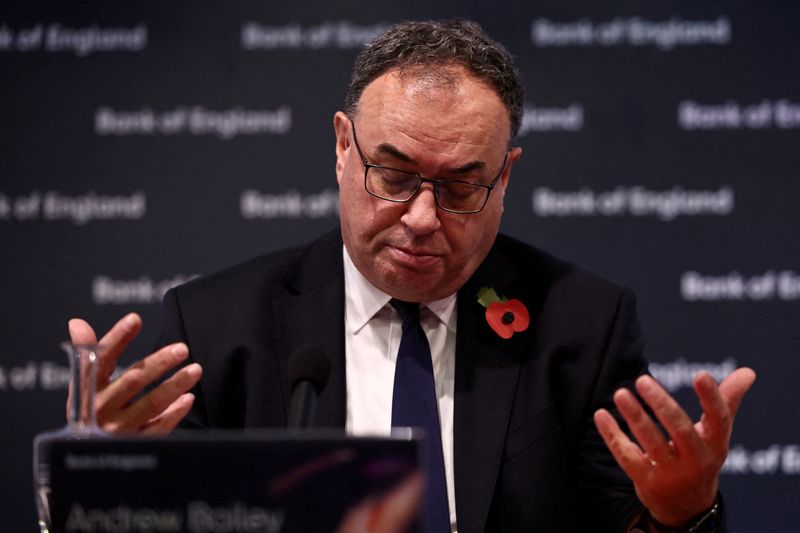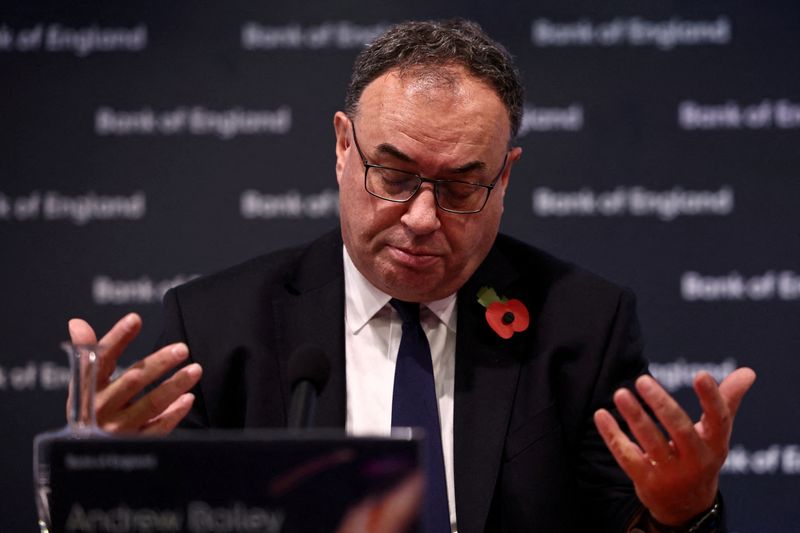Economy
Global central banks mark a possible plateau


© Reuters. Governor of the Bank of England Andrew Bailey addresses the media during a press conference concerning interest rates, at the Bank of England, in London, Britain, November 2, 2023. HENRY NICHOLLS/Pool via REUTERS
By Howard Schneider, William Schomberg and Francesco Canepa
(Reuters) – The Bank of England’s decision to hold its policy interest rate steady on Thursday puts the world’s three major central banks in a “higher-for-longer” holding pattern the length of which will hinge on how inflation behaves, the strength of U.S. growth and the depth of developing slowdowns in Europe and the UK, and whether bond markets sustain the higher borrowing costs that have attracted notice on both sides of the Atlantic.
No central bankers have declared the era of synchronized rate hikes over, and both Fed Chair Jerome Powell on Wednesday and Bank of England Governor Andrew Bailey on Thursday indicated their priority remained returning inflation to the shared 2% target, and that they were open to raising their benchmark short-term rates again if price pressures prove more persistent.
But the minutes of the Bank of England’s latest policy meeting nodded to a possible plateau.
“Market expectations for the paths of policy rates suggested that interest rates were at or near their peaks in the United Kingdom, the United States and the euro area,” the minutes stated. “Monetary policymakers in each jurisdiction had described the stance of monetary policy as restrictive,” with investors aligning behind the idea that rates will remain high at least into the middle of next year.
UK policymakers took a cue, as did those at the Fed the day before, from a rise in market-based interest rates that is expected to put a drag on economic activity throughout the major developed economies, further slowing growth in the euro zone and Great Britain that is already drifting below zero, and cooling U.S. growth that in the third quarter of this year was running at a likely unsustainable and inflationary 4.9%.
Long-term government bond yields, which are influenced by central banks’ short-term policy rates but ultimately set by investors, have “risen materially, with the largest moves seen in the United States,” the BOE’s Monetary Policy Committee noted in its minutes. “In part, that was likely to reflect market expectations that global policy rates would remain higher for longer during the current cycle.”
Both the Fed and ECB officials have set a similar tone, discounting talk of rate cuts to keep the focus on inflation.
The European Central Bank left interest rates unchanged as expected last week, ending an unprecedented streak of 10 consecutive rate hikes. But talk of rate cuts was premature, officials said, even though data showed euro zone inflation was falling fast and the economy had begun contracting. Combined with a collapse in credit creation, this meant the ECB had almost certainly finished raising rates, which are at record highs.
The Bank of Japan remains the outlier, still trying to put decades of too-low inflation behind it. But even officials there see a possible end to their easy money stance next year, with one risk being that they are forced to act faster if higher interest rates in other developed economies weaken the yen and push Japanese inflation higher.
For now, they’ll be little chance of help on that front from Frankfurt, London, or Washington, where policymakers uniformly say rate cuts won’t be on the table until price pressures are truly contained, a process that even in the U.S., where inflation at around 3.4% is closest to target, is expected to drag on.
“We are committed to achieving a stance of monetary policy that is sufficiently restrictive, to bring inflation sustainably down to 2% over time, and to keeping policy restrictive until we are confident that inflation is on the path to that objective,” Powell said on Wednesday.
“The risks have gotten more two-sided,” Powell said, an argument for avoiding any further rate increases unless it is unavoidable, but it may take a while, still, to declare victory.
Progress on inflation “is probably going to come in lumps,” Powell said. “It does take some time.”
Economy
Russian central bank says it needs months to make sure CPI falling before rate cuts -RBC


© Reuters. Russian Central Bank Governor Elvira Nabiullina attends a news conference in Moscow, Russia June 14, 2019. REUTERS/Shamil Zhumatov/File Photo
MOSCOW (Reuters) – Russia’s central bank will need two to three months to make sure that inflation is steadily declining before taking any decision on interest rate cuts, the bank’s governor Elvira Nabiullina told RBC media on Sunday.
The central bank raised its key interest rate by 100 basis points to 16% earlier in December, hiking for the fifth consecutive meeting in response to stubborn inflation, and suggested that its tightening cycle was nearly over.
Nabiullina said it was not yet clear when exactly the regulator would start cutting rates, however.
“We really need to make sure that inflation is steadily decreasing, that these are not one-off factors that can affect the rate of price growth in a particular month,” she said.
Nabiullina said the bank was taking into account a wide range of indicators but primarily those that “characterize the stability of inflation”.
“This will take two or three months or more – it depends on how much the wide range of indicators that characterize sustainable inflation declines,” she said.
The bank will next convene to set its benchmark rate on Feb. 16.
The governor also said the bank should have started monetary policy tightening earlier than in July, when it embarked on the rate-hiking cycle.
Economy
China identifies second set of projects in $140 billion spending plan


© Reuters. FILE PHOTO: Workers walk past an under-construction area with completed office towers in the background, in Shenzhen’s Qianhai new district, Guangdong province, China August 25, 2023. REUTERS/David Kirton/File Photo
SHANGHAI (Reuters) – China’s top planning body said on Saturday it had identified a second batch of public investment projects, including flood control and disaster relief programmes, under a bond issuance and investment plan announced in October to boost the economy.
With the latest tranche, China has now earmarked more than 800 billion yuan of its 1 trillion yuan ($140 billion) in additional government bond issuance in the fourth quarter, as it focuses on fiscal steps to shore up the flagging economy.
The National Development and Reform Commission (NDRC) said in a statement on Saturday it had identified 9,600 projects with planned investment of more than 560 billion yuan.
China’s economy, the world’s second largest, is struggling to regain its footing post-COVID-19 as policymakers grapple with tepid consumer demand, weak exports, falling foreign investment and a deepening real estate crisis.
The 1 trillion yuan in additional bond issuance will widen China’s 2023 budget deficit ratio to around 3.8 percent from 3 percent, the state-run Xinhua news agency has said.
“Construction of the projects will improve China’s flood control system, emergency response mechanism and disaster relief capabilities, and better protect people’s lives and property, so it is very significant,” the NDRC said.
The agency said it will coordinate with other government bodies to make sure that funds are allocated speedily for investment and that high standards of quality are maintained in project construction.
($1 = 7.1315 renminbi)
Economy
Russian central bank says it needs months to make sure CPI falling before rate cuts -RBC


© Reuters. Russian Central Bank Governor Elvira Nabiullina attends a news conference in Moscow, Russia June 14, 2019. REUTERS/Shamil Zhumatov/File Photo
MOSCOW (Reuters) – Russia’s central bank will need two to three months to make sure that inflation is steadily declining before taking any decision on interest rate cuts, the bank’s governor Elvira Nabiullina told RBC media on Sunday.
The central bank raised its key interest rate by 100 basis points to 16% earlier in December, hiking for the fifth consecutive meeting in response to stubborn inflation, and suggested that its tightening cycle was nearly over.
Nabiullina said it was not yet clear when exactly the regulator would start cutting rates, however.
“We really need to make sure that inflation is steadily decreasing, that these are not one-off factors that can affect the rate of price growth in a particular month,” she said.
Nabiullina said the bank was taking into account a wide range of indicators but primarily those that “characterize the stability of inflation”.
“This will take two or three months or more – it depends on how much the wide range of indicators that characterize sustainable inflation declines,” she said.
The bank will next convene to set its benchmark rate on Feb. 16.
The governor also said the bank should have started monetary policy tightening earlier than in July, when it embarked on the rate-hiking cycle.

 Forex2 years ago
Forex2 years agoForex Today: the dollar is gaining strength amid gloomy sentiment at the start of the Fed’s week

 Forex2 years ago
Forex2 years agoHow is the Australian dollar doing today?

 Forex1 year ago
Forex1 year agoUnbiased review of Pocket Option broker

 Forex2 years ago
Forex2 years agoDollar to pound sterling exchange rate today: Pound plummeted to its lowest since 1985

 Cryptocurrency2 years ago
Cryptocurrency2 years agoWhat happened in the crypto market – current events today

 World2 years ago
World2 years agoWhy are modern video games an art form?

 Stock Markets2 years ago
Stock Markets2 years agoMorgan Stanley: bear market rally to continue

 Economy2 years ago
Economy2 years agoCrude oil tankers double in price due to EU anti-Russian sanctions

































